Comparison of Machine Learning Algorithms for Daily Runoff Forecasting with Global Rainfall Products in Algeria
Abstract
1. Introduction
- Compare four different satellite rainfall products with high spatial and temporal resolution: Global Precipitation Measurement Integrated Multi-Satellite Retrievals (GPM-IMERGs), Climate Hazards Group Infrared Precipitation with Station data (CHIRPS), Precipitation Estimation from Remote Sensed Information using Artificial Neural Networks (PERSIANN), Soil Moisture to Rain (SM2RAIN-ASCAT), and a reanalysis product (ERA5).
- Simulate river discharge from satellite rainfall and evaluate the performance of eight types of models: the 4-Parameter Daily Rural Engineering model (GR4J), feed-forward neural networks (FFNNs), extreme machine learning (ELM), long short-term memory (LSTM), LSTM2, gated recurrent unit (GRU), Gaussian process regression (GPR), and Support Vector Machine (SVM).
2. Materials and Methods
2.1. Study Area
2.2. Datasets
2.2.1. Global Precipitation Products
GPM-IMERG
SM2RAIN-ASCAT
PERSIANN-CCS-CDR
CHIRPS
ERA5
2.2.2. Evapotranspiration Data
2.3. Methods
2.3.1. Analysis of Catchment Response Time
2.3.2. Conceptual Hydrological Model (GR4J)
2.3.3. Machine Learning Models
Feed-Forward Neural Network (FFNN)
Extreme Learning Machine (ELM)
Long Short-Term Memory (LSTM)
Gated Recurrent Unit (GRU)
Gaussian Process Regression (GPR)
Support Vector Machine (SVM)
2.3.4. Hydrological Model Evaluation
- -
- Validation with GR4J
- -
- Validation with Machine Learning Techniques
2.3.5. Efficiency Criteria
2.3.6. Taylor Diagram
3. Results
3.1. Impact of Time Lag Between Rainfall and Runoff on Hydrological Forecast Accuracy
3.2. Which Global Rainfall Product Is the Most Effective?
3.3. The Most Effective Model Structure
4. Discussion
5. Conclusions
Author Contributions
Funding
Data Availability Statement
Conflicts of Interest
References
- Gowda, C.C.; Mahesha, A.; Mayya, S.G. Development of operation policy for dry season reservoirs in tropical partially gauged river basins. Int. J. River Basin Manag. 2022, 22, 187–201. [Google Scholar] [CrossRef]
- El Khalki, E.M.; Tramblay, Y.; Massari, C.; Brocca, L.; Simonneaux, V.; Gascoin, S.; Saidi, M.E.M. Challenges in flood modeling over data-scarce regions: How to exploit globally available soil moisture products to estimate antecedent soil wetness conditions in Morocco. Nat. Hazards Earth Syst. Sci. 2020, 20, 2591–2607. [Google Scholar] [CrossRef]
- Sayama, T.; Tatebe, Y.; Tanaka, S. An emergency response-type rainfall-runoff-inundation simulation for 2011 Thailand floods. J. Flood Risk Manag. 2017, 10, 65–78. [Google Scholar] [CrossRef]
- Chen, Y.; Li, J.; Xu, H. Improving flood forecasting capability of physically based distributed hydrological models by parameter optimization. Hydrol. Earth Syst. Sci. 2016, 20, 375–392. [Google Scholar] [CrossRef]
- Unduche, F.; Tolossa, H.; Senbeta, D.; Zhu, E. Evaluation of four hydrological models for operational flood forecasting in a Canadian Prairie watershed. Hydrol. Sci. J. 2018, 63, 1133–1149. [Google Scholar] [CrossRef]
- Kan, G.; He, X.; Ding, L.; Li, J.; Liang, K.; Hong, Y. Study on applicability of conceptual hydrological models for flood forecasting in humid, semi-humid semi-arid and arid basins in China. Water 2017, 9, 719. [Google Scholar] [CrossRef]
- Hadid, B.; Duviella, E.; Lecoeuche, S. Data-driven modeling for river flood forecasting based on a piecewise linear ARX system identification. J. Process. Control 2019, 86, 44–56. [Google Scholar] [CrossRef]
- Boulmaiz, T.; Guermoui, M.; Boutaghane, H. Impact of training data size on the LSTM performances for rainfall–runoff modeling. Model. Earth Syst. Environ. 2020, 6, 2153–2164. [Google Scholar] [CrossRef]
- Roy, B.; Singh, M.P.; Kaloop, M.R.; Kumar, D.; Hu, J.-W.; Kumar, R.; Hwang, W.-S. Data-driven approach for rainfall-runoff modelling using equilibrium optimizer coupled extreme learning machine and deep neural network. Appl. Sci. 2021, 11, 6238. [Google Scholar] [CrossRef]
- Mazrooei, A.; Sankarasubramanian, A. Improving monthly streamflow forecasts through assimilation of observed streamflow for rainfall-dominated basins across the CONUS. J. Hydrol. 2019, 575, 704–715. [Google Scholar] [CrossRef]
- Ahani, A.; Shourian, M.; Rad, P.R. Performance assessment of the linear, nonlinear and nonparametric data driven models in river flow forecasting. Water Resour. Manag. 2017, 32, 383–399. [Google Scholar] [CrossRef]
- Xu, T.; Liang, F. Machine learning for hydrologic sciences: An introductory overview. WIREs Water 2021, 8, e1533. [Google Scholar] [CrossRef]
- Nearing, G.S.; Kratzert, F.; Sampson, A.K.; Pelissier, C.S.; Klotz, D.; Frame, J.M.; Prieto, C.; Gupta, H.V. What role does hydrological science play in the age of machine learning? Water Resour. Res. 2021, 57, e2020WR028091. [Google Scholar] [CrossRef]
- Alizadeh, A.; Rajabi, A.; Shabanlou, S.; Yaghoubi, B.; Yosefvand, F. Modeling long-term rainfall-runoff time series through wavelet-weighted regularization extreme learning machine. Earth Sci. Inform. 2021, 14, 1047–1063. [Google Scholar] [CrossRef]
- Tașar, B.; Üneş, F.; Varçin, H. Prediction of the rainfall—runoff relationship using neuro-fuzzy and support vector machines. In Proceedings of the Air and Water Components of the Environment 2019 Conference, Cluj-Napoca, Romania, 22–24 March 2019. [Google Scholar]
- Granata, F.; Gargano, R.; De Marinis, G. Support vector regression for rainfall-runoff modeling in urban drainage: A comparison with the epa’s storm water management model. Water 2016, 8, 69. [Google Scholar] [CrossRef]
- Xu, Y.; Hu, C.; Wu, Q.; Jian, S.; Li, Z.; Chen, Y.; Zhang, G.; Zhang, Z.; Wang, S. Research on particle swarm optimization in LSTM neural networks for rainfall-runoff simulation. J. Hydrol. 2022, 608, 127553. [Google Scholar] [CrossRef]
- Gao, S.; Huang, Y.; Zhang, S.; Han, J.; Wang, G.; Zhang, M.; Lin, Q. Short-term runoff prediction with GRU and LSTM networks without requiring time step optimization during sample generation. J. Hydrol. 2020, 589, 125188. [Google Scholar] [CrossRef]
- Abdi, I.; Meddi, M. Comparison of conceptual rainfall–runoff models in semi-arid watersheds of eastern Algeria. J. Flood Risk Manag. 2020, 14, e12672. [Google Scholar] [CrossRef]
- Zeroual, A.; Meddi, M.; Assani, A.A. Artificial Neural Network Rainfall-Discharge Model Assessment Under Rating Curve Uncertainty and Monthly Discharge Volume Predictions. Water Resour. Manag. 2016, 30, 3191–3205. [Google Scholar] [CrossRef]
- Nourani, V.; Gökçekuş, H.; Gichamo, T. Ensemble data-driven rainfall-runoff modeling using multi-source satellite and gauge rainfall data input fusion. Earth Sci. Inform. 2021, 14, 1787–1808. [Google Scholar] [CrossRef]
- Parisouj, P.; Lee, T.; Mohebzadeh, H.; Khani, H.M. Rainfall-runoff simulation using satellite rainfall in a scarce data catchment. J. Appl. Water Eng. Res. 2021, 9, 161–174. [Google Scholar] [CrossRef]
- Yeditha, P.K.; Rathinasamy, M.; Neelamsettya, S.S.; Bhattacharyab, B.; Agarwalc, A. Investigation of satellite rainfall-driven rainfall–runoff model using deep learning approaches in two different catchments in India. J. Hydroinform. 2021, 24, 16–37. [Google Scholar] [CrossRef]
- Tramblay, Y.; El Khalki, E.M.; Ciabatta, L.; Camici, S.; Hanich, L.; Saidi, M.E.M.; Ezzahouani, A.; Benaabidate, L.; Mahé, G.; Brocca, L. River runoff estimation with satellite rainfall in Morocco. Hydrol. Sci. J. 2023, 68, 474–487. [Google Scholar] [CrossRef]
- Cantoni, E.; Tramblay, Y.; Grimaldi, S.; Salamon, P.; Dakhlaoui, H.; Dezetter, A.; Thiemig, V. Hydrological performance of the ERA5 reanalysis for flood modeling in Tunisia with the LISFLOOD and GR4J models. J. Hydrol. Reg. Stud. 2022, 42, 101169. [Google Scholar] [CrossRef]
- Gadhawe, M.A.; Guntu, R.K.; Agarwal, A. Network-based exploration of basin precipitation based on satellite and observed data. Eur. Phys. J. Spéc. Top. 2021, 230, 3343–3357. [Google Scholar] [CrossRef]
- Ali, S.; Shahbaz, M. Streamflow forecasting by modeling the rainfall–streamflow relationship using artificial neural networks. Model. Earth Syst. Environ. 2020, 6, 1645–1656. [Google Scholar] [CrossRef]
- Satgé, F.; Hussain, Y.; Molina-Carpio, J.; Pillco, R.; Laugner, C.; Akhter, G.; Bonnet, M. Reliability of SM2RAIN precipitation datasets in comparison to gauge observations and hydrological modelling over arid regions. Int. J. Clim. 2020, 41, E517–E536. [Google Scholar] [CrossRef]
- Alazzy, A.A.; Lü, H.; Chen, R.; Ali, A.B.; Zhu, Y.; Su, J. Evaluation of Satellite Precipitation Products and Their Potential Influence on Hydrological Modeling over the Ganzi River Basin of the Tibetan Plateau. Adv. Meteorol. 2017, 2017, 3695285. [Google Scholar] [CrossRef]
- Akbaş, A.; Ozdemir, H. Comparing Satellite, Reanalysis, Fused and Gridded (In Situ) Precipitation Products Over Türkiye. Int. J. Climatol. 2024, 44, 5873–5889. [Google Scholar] [CrossRef]
- Anjum, M.N.; Irfan, M.; Waseem, M.; Leta, M.K.; Niazi, U.M.; Rahman, S.U.; Ghanim, A.; Mukhtar, M.A.; Nadeem, M.U. Assessment of PERSIANN-CCS, PERSIANN-CDR, SM2RAIN-ASCAT, and CHIRPS-2.0 Rainfall Products over a Semi-Arid Subtropical Climatic Region. Water 2022, 14, 147. [Google Scholar] [CrossRef]
- Najmi, A.; Igmoullan, B.; Namous, M.; El Bouazzaoui, I.; Brahim, Y.A.; El Khalki, E.M.; Saidi, M.E.M. Evaluation of PERSIANN-CCS-CDR, ERA5, and SM2RAIN-ASCAT rainfall products for rainfall and drought assessment in a semi-arid watershed, Morocco. J. Water Clim. Change 2023, 14, 1569–1584. [Google Scholar] [CrossRef]
- Skofronick-Jackson, G.; Kirschbaum, D.; Petersen, W.; Huffman, G.; Kidd, C.; Stocker, E.; Kakar, R. The Global Precipitation Measurement (GPM) mission’s scientific achievements and societal contributions: Reviewing four years of advanced rain and snow observations. Q. J. R. Meteorol. Soc. 2018, 144, 27–48. [Google Scholar] [CrossRef] [PubMed]
- Brocca, L.; Filippucci, P.; Hahn, S.; Ciabatta, L.; Massari, C.; Camici, S.; Schüller, L.; Bojkov, B.; Wagner, W. SM2RAIN–ASCAT (2007–2018): Global daily satellite rainfall data from ASCAT soil moisture observations. Earth Syst. Sci. Data 2019, 11, 1583–1601. [Google Scholar] [CrossRef]
- Brocca, L.; Massari, C.; Ciabatta, L.; Moramarco, T.; Penna, D.; Zuecco, G.; Pianezzola, L.; Borga, M.; Matgen, P.; Martínez-Fernández, J. Rainfall estimation from in situ soil moisture observations at several sites in Europe: An evaluation of the SM2RAIN algorithm. J. Hydrol. Hydromech. 2015, 63, 201–209. [Google Scholar] [CrossRef]
- Koohi, S.; Azizian, A.; Brocca, L. Spatiotemporal drought monitoring using bottom-up precipitation dataset (SM2RAIN-ASCAT) over different regions of Iran. Sci. Total. Environ. 2021, 779, 146535. [Google Scholar] [CrossRef]
- Ashouri, H.; Hsu, K.-L.; Sorooshian, S.; Braithwaite, D.K.; Knapp, K.R.; Cecil, L.D.; Nelson, B.R.; Prat, O.P. PERSIANN-CDR: Daily precipitation climate data record from multisatellite observations for hydrological and climate studies. Bull. Am. Meteorol. Soc. 2015, 96, 69–83. [Google Scholar] [CrossRef]
- Sadeghi, M.; Nguyen, P.; Naeini, M.R.; Hsu, K.; Braithwaite, D.; Sorooshian, S. PERSIANN-CCS-CDR, a 3-hourly 0.04° global precipitation climate data record for heavy precipitation studies. Sci. Data 2021, 8, 157. [Google Scholar] [CrossRef]
- Funk, C.; Peterson, P.; Landsfeld, M.; Pedreros, D.; Verdin, J.; Shukla, S.; Husak, G.; Rowland, J.; Harrison, L.; Hoell, A.; et al. The climate hazards infrared precipitation with stations—A new environmental record for monitoring extremes. Sci. Data 2015, 2, 150066. [Google Scholar] [CrossRef]
- Funk, C.C.; Peterson, P.J.; Landsfeld, M.F.; Pedreros, D.H.; Verdin, J.P.; Rowland, J.D.; Romero, B.E.; Husak, G.J.; Michaelsen, J.C.; Verdin, A.P. A quasi-global precipitation time series for drought monitoring. US Geol. Surv. Data Ser. 2014, 832, 1–12. [Google Scholar]
- Katsanos, D.; Retalis, A.; Michaelides, S. Validation of a high-resolution precipitation database (CHIRPS) over Cyprus for a 30-year period. Atmos. Res. 2016, 169, 459–464. [Google Scholar] [CrossRef]
- Hersbach, H.; Bell, B.; Berrisford, P.; Horányi, A.; Sabater, J.M.; Nicolas, J.; Radu, R.; Schepers, D.; Simmons, A.; Soci, C.; et al. Global reanalysis: Goodbye ERA-Interim, hello ERA5. ECMWF Newsl. 2019, 159, 17. [Google Scholar]
- Hersbach, H.; Bell, B.; Berrisford, P.; Hirahara, S.; Horányi, A.; Muñoz-Sabater, J.; Nicolas, J.; Peubey, C.; Radu, R.; Schepers, D.; et al. The ERA5 global reanalysis. Q. J. R. Meteorol. Soc. 2020, 146, 1999–2049. [Google Scholar] [CrossRef]
- Belkhiri, F.E. Performance evaluation of eighteen models for estimating reference evapotranspiration under subhumid conditions of Mitidja, Algeria. Rech. Agron. 2020, 19, 5–32. Available online: https://asjp.cerist.dz/en/article/148748 (accessed on 5 February 2025).
- Ndiaye, P.M.; Bodian, A.; Diop, L.; Djaman, K. Evaluation of twenty methods for estimating daily reference evapotranspiration in Burkina Faso. Physio-Géo 2017, 11, 129–146. [Google Scholar] [CrossRef]
- Perrin, C.; Michel, C.; Andréassian, V. Improvement of a Parsimonious Model for Streamflow Simulation. J. Hydrol. 2003, 279, 275–289. [Google Scholar] [CrossRef]
- Chen, L.; Sun, N.; Zhou, C.; Zhou, J.; Zhou, Y.; Zhang, J.; Zhou, Q. Flood Forecasting Based on an Improved Extreme Learning Machine Model Combined with the Backtracking Search Optimization Algorithm. Water 2018, 10, 1362. [Google Scholar] [CrossRef]
- Ghimire, S.; Deo, R.C.; Raj, N.; Mi, J. Deep solar radiation forecasting with convolutional neural network and long short-term memory network algorithms. Appl. Energy 2019, 253, 113541. [Google Scholar] [CrossRef]
- Guermoui, M.; Rabehi, A.; Benkaciali, S.; Djafer, D. Daily global solar radiation modelling using multi-layer perceptron neural networks in semi-arid region. Leonardo Electron. J. Pract. Technol. 2016, 15, 35–46. [Google Scholar]
- Huang, G.-B.; Zhou, H.; Ding, X.; Zhang, R. Extreme learning machine for regression and multiclass classification. IEEE Trans. Syst. Man Cybern. Part B Cybern. 2012, 42, 513–529. [Google Scholar] [CrossRef]
- Huang, G.-B.; Zhu, Q.-Y.; Siew, C.-K. Extreme learning machine: Theory and applications. Neurocomputing 2006, 70, 489–501. [Google Scholar] [CrossRef]
- Kratzert, F.; Klotz, D.; Brenner, C.; Schulz, K.; Herrnegger, M. Rainfall–runoff modelling using long short-term memory (LSTM) networks. Hydrol. Earth Syst. Sci. 2018, 22, 6005–6022. [Google Scholar] [CrossRef]
- Hochreiter, S.; Schmidhuber, J. Long Short-Term Memory. Neural Comput. 1997, 9, 1735–1780. [Google Scholar] [CrossRef] [PubMed]
- Chung, J.; Gulcehre, C.; Cho, K.; Bengio, Y. Empirical evaluation of gated recurrent neural networks on sequence modeling. arXiv 2014, arXiv:1412.3555. [Google Scholar]
- Grbić, R.; Kurtagić, D.; Slišković, D. Stream water temperature prediction based on Gaussian process regression. Expert Syst. Appl. 2013, 40, 7407–7414. [Google Scholar] [CrossRef]
- Rasmussen, C.E.; Williams, C.K.I. Gaussian Processes for Machine Learning, 3. Print; MIT Press: Cambridge, MA, USA, 2008. [Google Scholar]
- Hipni, A.; El-Shafie, A.; Najah, A.; Karim, O.A.; Hussain, A.; Mukhlisin, M. Daily Forecasting of Dam Water Levels: Comparing a Support Vector Machine (SVM) Model With Adaptive Neuro Fuzzy Inference System (ANFIS). Water Resour. Manag. 2013, 27, 3803–3823. [Google Scholar] [CrossRef]
- Cortes, C.; Vapnik, V. Support-vector networks. Mach. Learn. 1995, 20, 273–297. [Google Scholar] [CrossRef]
- Nash, J. River flow forecasting through conceptual models, I: A discussion of principles. J. Hydrol. 1970, 10, 398–409. [Google Scholar] [CrossRef]
- Gupta, H.V.; Kling, H.; Yilmaz, K.K.; Martinez, G.F. Decomposition of the mean squared error and NSE performance criteria: Implications for improving hydrological modelling. J. Hydrol. 2009, 377, 80–91. [Google Scholar] [CrossRef]
- Kling, H.; Fuchs, M.; Paulin, M. Runoff conditions in the upper Danube basin under an ensemble of climate change scenarios. J. Hydrol. 2012, 424–425, 264–277. [Google Scholar] [CrossRef]
- Le, X.-H.; Nguyen, D.-H.; Jung, S.; Yeon, M.; Lee, G. Comparison of Deep Learning Techniques for River Streamflow Forecasting. IEEE Access 2021, 9, 71805–71820. [Google Scholar] [CrossRef]
- Zahar, Y.; Ghorbel, A.; Albergel, J. Impacts of large dams on downstream flow conditions of rivers: Aggradation and reduction of the Medjerda channel capacity downstream of the Sidi Salem dam (Tunisia). J. Hydrol. 2008, 351, 318–330. [Google Scholar] [CrossRef]
- Sadaoui, M.; Ludwig, W.; Bourrin, F.; Le Bissonnais, Y.; Romero, E. Anthropogenic Reservoirs of Various Sizes Trap Most of the Sediment in the Mediterranean Maghreb Basin. Water 2018, 10, 927. [Google Scholar] [CrossRef]
- Remini, B.; Achour, B.; Kechad, R. Traditional techniques for increasing the discharge from qanats in Algeria. Irrig. Drain. Syst. 2011, 25, 293–306. [Google Scholar] [CrossRef]
- Ouassanouan, Y.; Fakir, Y.; Simonneaux, V.; Kharrou, M.H.; Bouimouass, H.; Najar, I.; Benrhanem, M.; Sguir, F.; Chehbouni, A. Multi-decadal analysis of water resources and agricultural change in a Mediterranean semiarid irrigated piedmont under water scarcity and human interaction. Sci. Total Environ. 2022, 834, 155328. [Google Scholar] [CrossRef]
- Tramblay, Y.; El Khalki, E.M.; Khedimallah, A.; Sadaoui, M.; Benaabidate, L.; Boulmaiz, T.; Boutaghane, H.; Dakhlaoui, H.; Hanich, L.; Ludwig, W.; et al. Regional flood frequency analysis in North Africa. J. Hydrol. 2024, 630, 130678. [Google Scholar] [CrossRef]
- Kapoor, A.; Pathiraja, S.; Marshall, L.; Chandra, R. DeepGR4J: A deep learning hybridization approach for conceptual rainfall-runoff modelling. Environ. Model. Softw. 2023, 169, 105831. [Google Scholar] [CrossRef]
- Kwon, M.; Kwon, H.-H.; Han, D. A Hybrid Approach Combining Conceptual Hydrological Models, Support Vector Machines and Remote Sensing Data for Rainfall-Runoff Modeling. Remote. Sens. 2020, 12, 1801. [Google Scholar] [CrossRef]
- Okkan, U.; Ersoy, Z.B.; Kumanlioglu, A.A.; Fistikoglu, O. Embedding machine learning techniques into a conceptual model to improve monthly runoff simulation: A nested hybrid rainfall-runoff modeling. J. Hydrol. 2021, 598, 126433. [Google Scholar] [CrossRef]
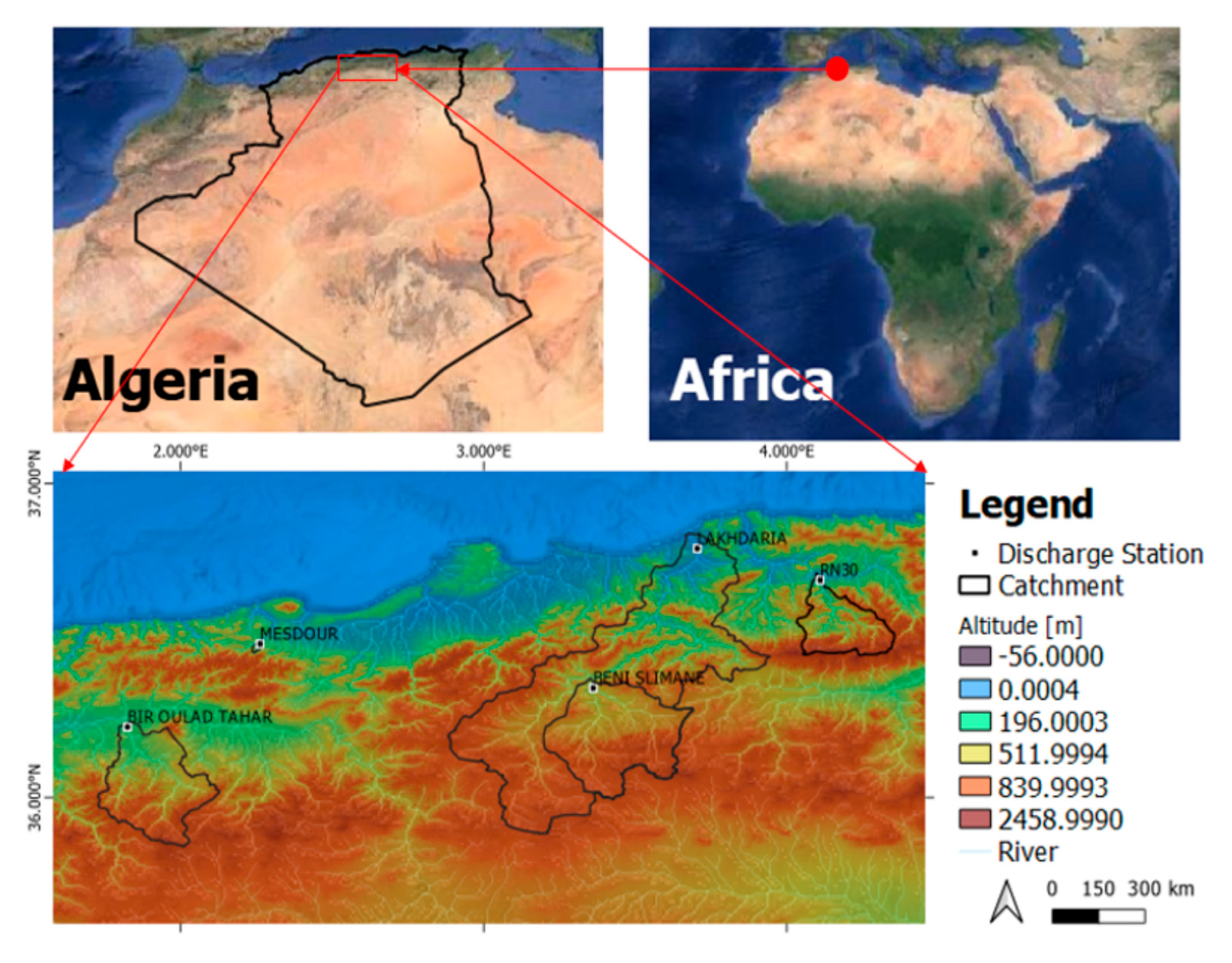
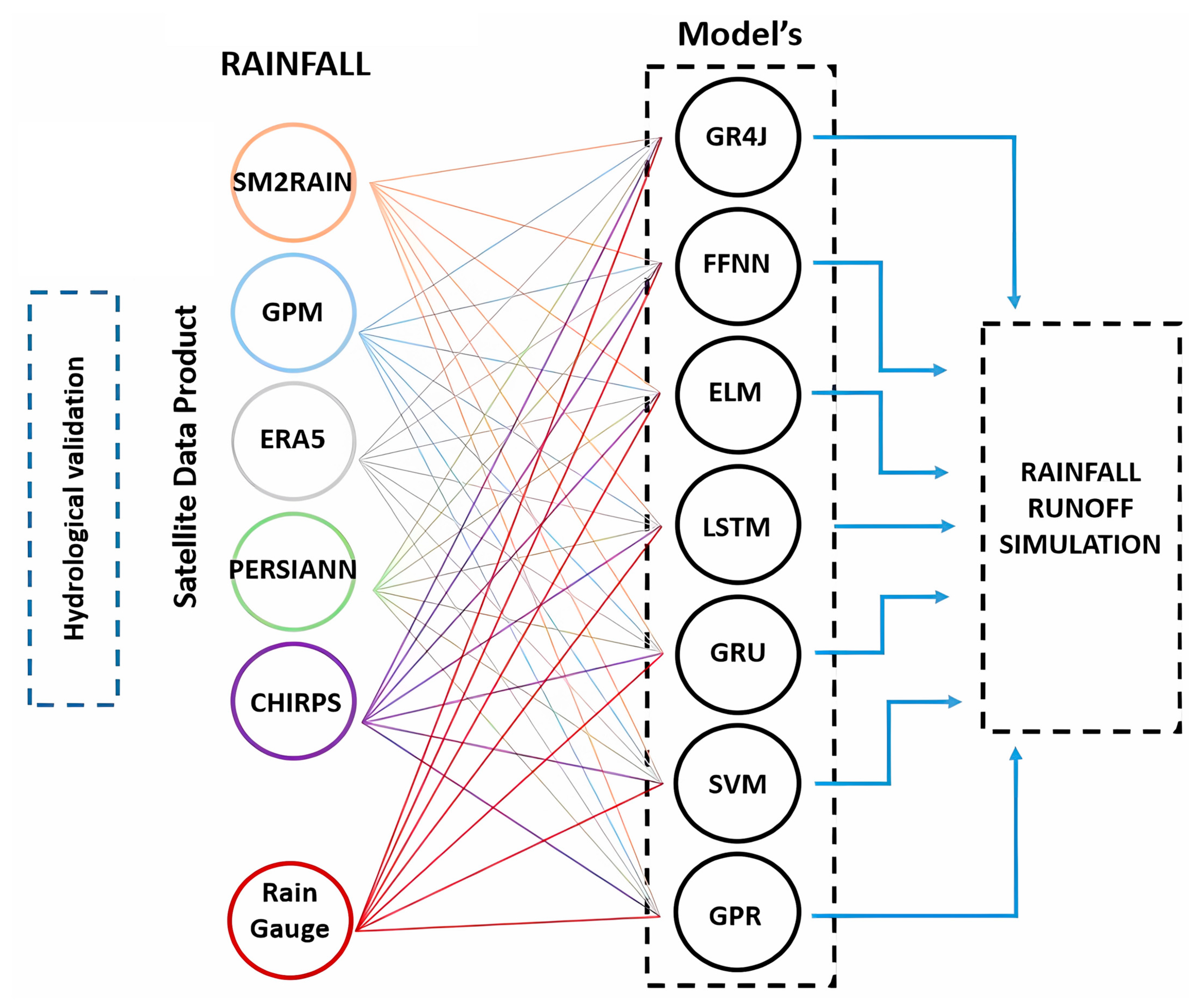
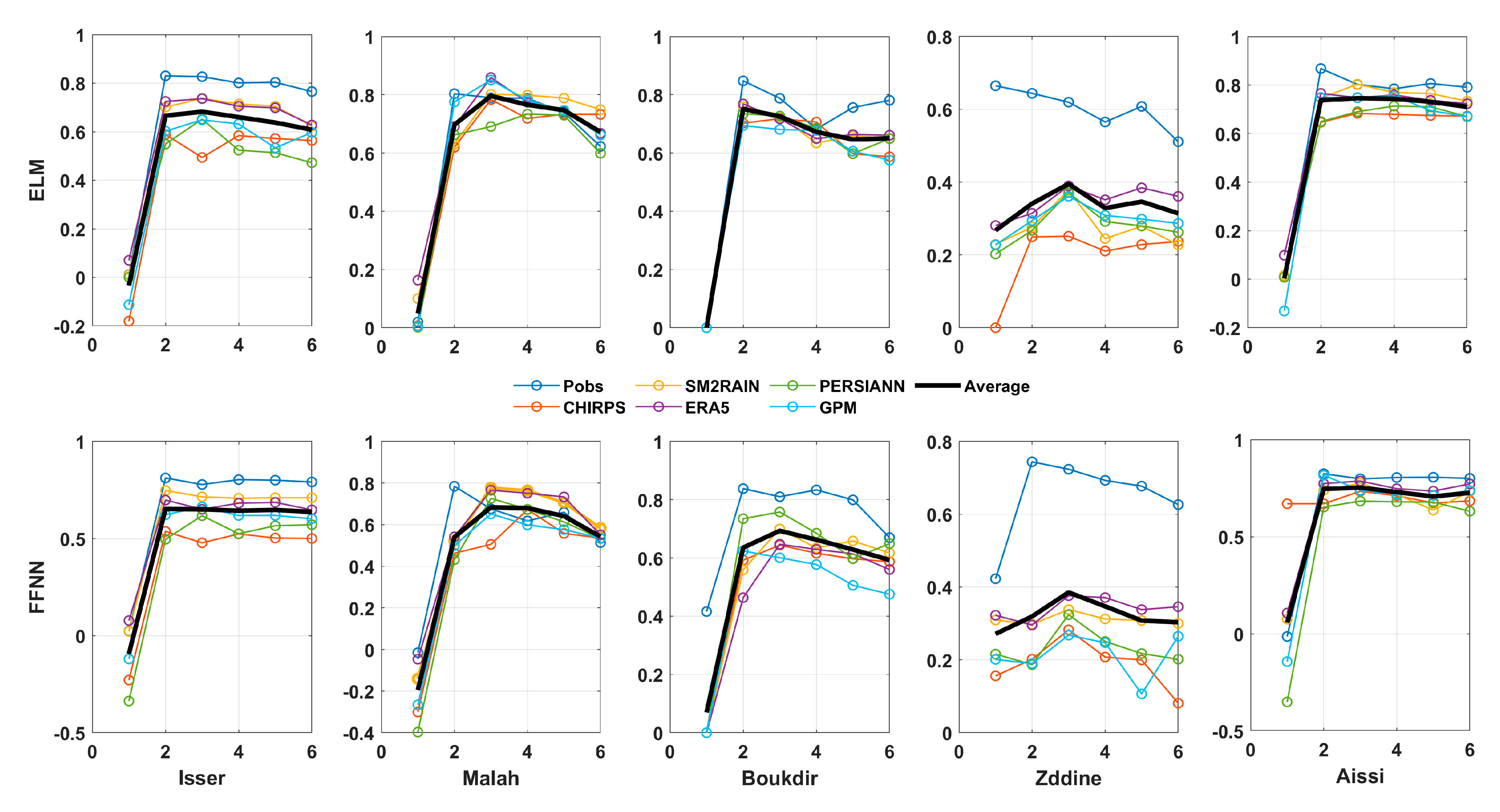


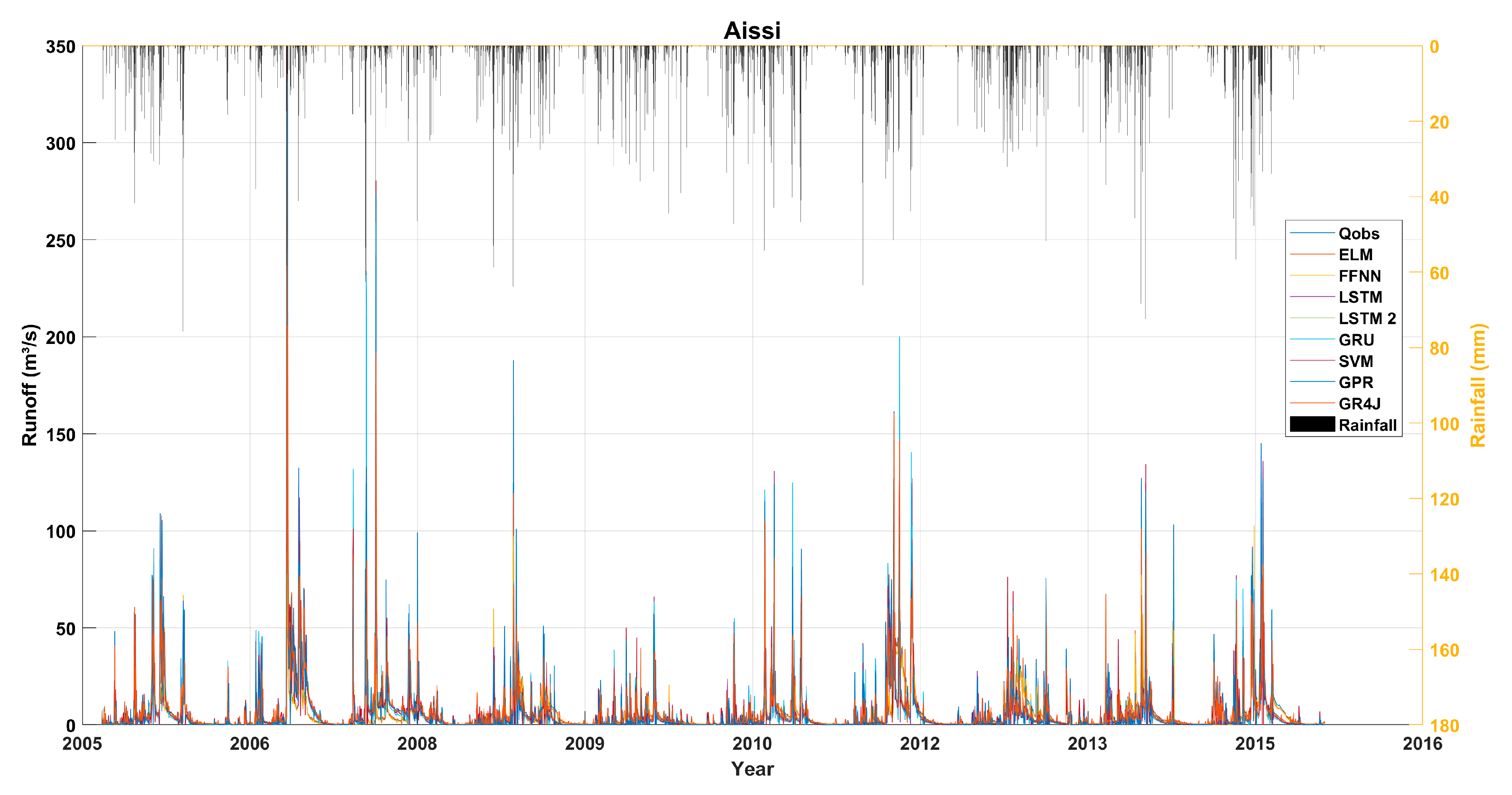
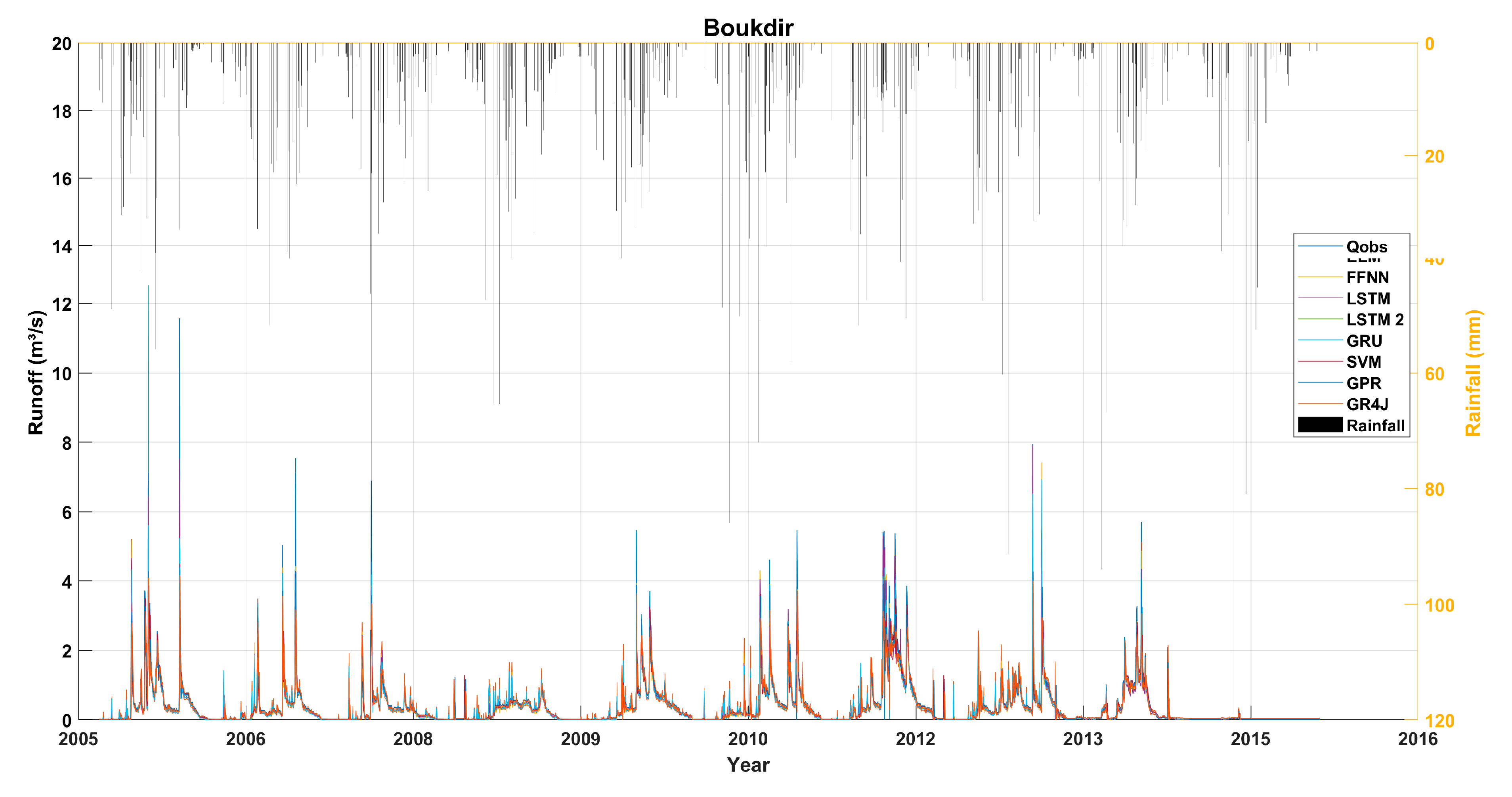
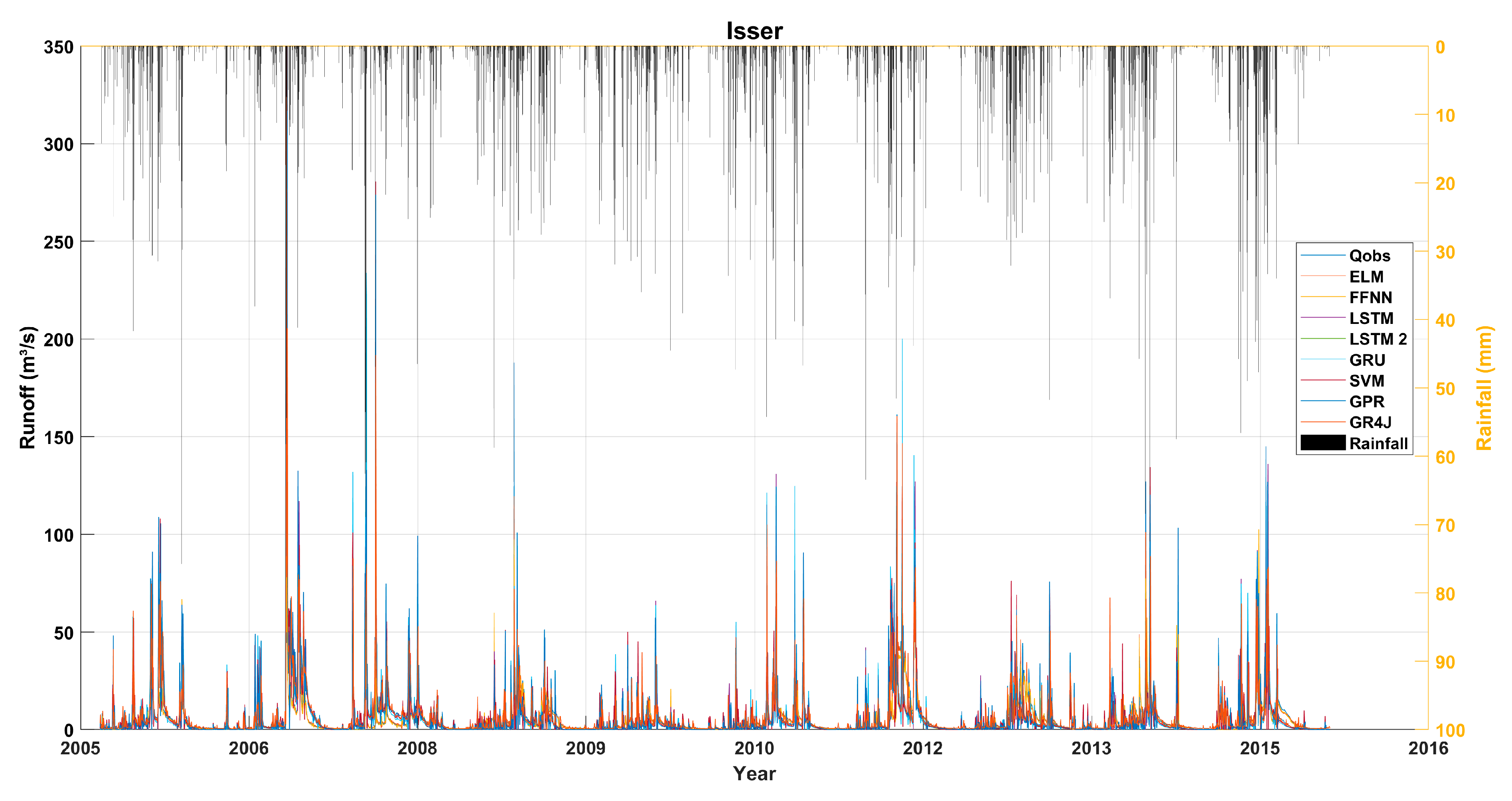
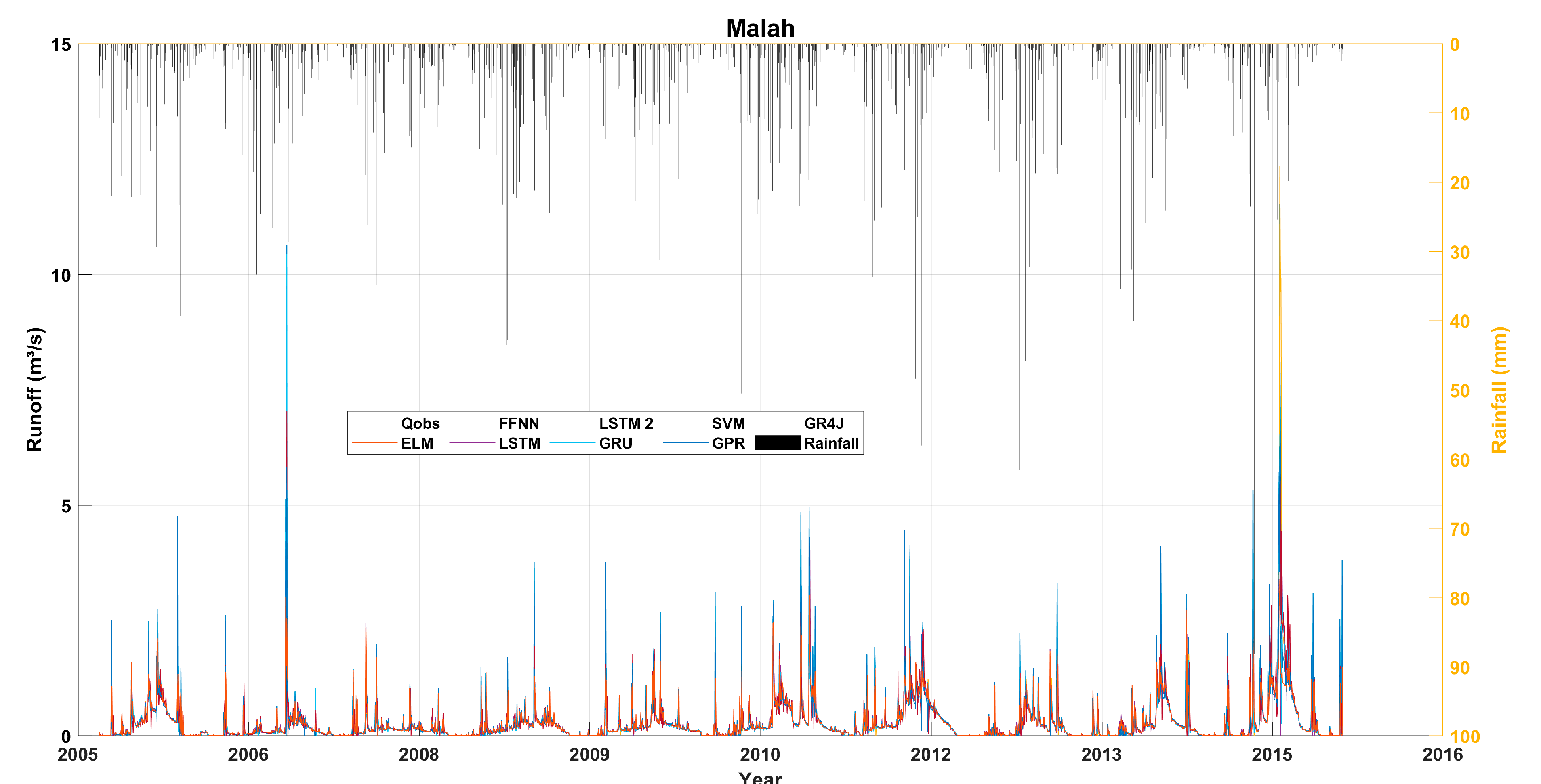


| Products Evaluated | Study Region | Approach Used | Main Results and Performance | Best Performing Product | Reference |
|---|---|---|---|---|---|
| ERA5, soil moisture products | Morocco | Flood modeling | ERA5 and SM2RAIN-ASCAT provide a better estimate of soil moisture conditions for flood prediction. | ERA5 and ASCAT | El Khalki et al. (2020) [2] |
| GPM, CHIRPS | India | Deep Learning modeling | Deep learning approaches improve rainfall–runoff simulation. GPM (R2 = 0.84, RMSE = 10.5 mm) and CHIRPS (R2 = 0.80, RMSE = 11.8 mm) offer good spatialization. | CHIRPS | Yeditha et al. (2021) [23] |
| EUMETSAT H SAF, SM2RAIN-ASCAT, IMERG | Morocco | Rainfall–runoff simulation | SM2RAIN-ASCAT shows a strong correlation, particularly in basins with high interannual variability. | SM2RAIN-ASCAT | Tramblay et al. (2023) [24] |
| SM2RAIN, rain gauges | South Asia | Comparison with observations | SM2RAIN-ASCAT offers precision compared with the other SM2RAIN and rain gauges. | SM2RAIN-ASCAT | Satgé et al. (2021) [28] |
| GPM-IMERG, CMORPH, TRMM | Tibetan Plateau | Hydrological assessment | The GPM-IMERG products show robust results for the evaluation of precipitation in relation to the TRMM and CMORPH. | GPM-IMERG | Alazzy et al. (2017) [29] |
| PERSIANN, ERA5, GPM, TRMM, merged products, etc. | Turkey | Statistical comparison | ERA5 shows robust results for precipitation assessment, but merging the products increases accuracy. | ERA5 | Akbaş and Ozdemir (2024) [30] |
| CHIRPS, SM2RAIN-ASCAT, PERSIANN | Pakistan | Multi-criteria assessment | CHIRPS and SM2RAIN-ASCAT faithfully track the spatio-temporal variability of rainfall observed in the subtropical semi-arid region. | CHIRPS and SM2RAIN-ASCAT | Anjum et al. (2022) [31] |
| PERSIANN, ERA5, SM2RAIN-ASCAT | Morocco | Drought assessment | ERA5 performs well for drought analysis, while SM2RAIN-ASCAT shows good reliability for rainfall characterization. | ERA5 | Najmi et al. (2023) [32] |
| Bassin | Boukdir | Isser | Zddine | Malah Est | Aissi |
|---|---|---|---|---|---|
| Area [km2] Annual rainfall [mm] Annual temperature [°C] | 76 | 3615 | 418 | 274 | 431 |
| 642.4 | 660 | 461 | 467.2 | 910 | |
| 17.6 | 34 | 22 | 16.4 | 20 | |
| Perimeter [km] Code | 95.3 | 442 | 295 | 320.2 | 109.15 |
| 020331 | 090501 | 011905 | 090905 | 021715 | |
| Station X [km] Y [km] PERIOD | MESDOUR | LAKHDARIA | BIR OULED TAHAR | BENI SLIMANE | RN30 |
| 461,000 | 579,100 | 432,000 | 557,000 | 628,000 | |
| 355,000 | 368,750 | 312,000 | 322,000 | 372,000 | |
| 1993–2014 | 1986–2018 | 1990–2015 | 1985–2015 | 1986–2015 |
| Catchment | Code | Station | X [km] | Y [km] | PERIOD |
|---|---|---|---|---|---|
| Zddine | 011901 | EL TOUAIGIA | 430.85 | 313.35 | 1972–2018 |
| 011903 | TOUTIA ELHASSANIA | 429.95 | 294.45 | 1927–2018 | |
| 011904 | ROUINA MAIRE | 419.8 | 327.3 | 1972–2018 | |
| Boukdir | 020303 | MENCEUR | 458.25 | 354.45 | 1972–2019 |
| 020304 | IAZABENE | 462.35 | 352.15 | 1972–2012 | |
| Aissi | 021705 | LARBAA NTHIRATHEN | 634.9 | 370.8 | 1972–2012 |
| 021712 | BENI YENNI | 635 | 365.25 | 1972–2019 | |
| 021716 | AIT OUABANE | 643.3 | 354.7 | 1988–2017 | |
| 021717 | AIT DJEMAA | 621.45 | 356.85 | 1988–2018 | |
| Malah Est | 090301 | DJOUAB | 566.95 | 315.55 | 1972–2019 |
| 090302 | BNI SLIMANE | 557.2 | 322.65 | 1972–2019 | |
| 090314 | DECHMYA | 578.5 | 316.35 | 1974–2019 | |
| Isser | 090502 | LAKHDARIA GORGES | 579.3 | 370 | 1972–2018 |
| Rainfall Product | Spatial Resolution | Spatial Coverage | Temporal Resolution | Time Period Availability | Data Sources |
|---|---|---|---|---|---|
| GPM | 0.1° | 60 S/60 N | 30 min | 2000–present | (https://gpm.nasa.gov, accessed on 5 February 2025) |
| SM2RAIN | 0.125° | 60 S/60 N | Daily | 2007–2020 | (https://zenodo.org/record/6136294, accessed on 5 February 2025) |
| PERSIANN-CCS-CDR | 0.04° | 60 S/60 N | Every 3 h | 1983–present | (https://www.ncei.noaa.gov/data/precipitation-persiann/access/, accessed on 5 February 2025) |
| CHIRPS | 0.05° | 50 S/50 N | Daily | 1981–present | (https://chc.ucsb.edu/data/chirp, accessed on 5 February 2025) |
| ERA5 | 0.33° | 60 S/60 N | 1 h | 1950–2022 | (https://www.ecmwf.int/en/forecasts/dataset/ecmwf-reanalysis-v5, accessed on 5 February 2025) |
Disclaimer/Publisher’s Note: The statements, opinions and data contained in all publications are solely those of the individual author(s) and contributor(s) and not of MDPI and/or the editor(s). MDPI and/or the editor(s) disclaim responsibility for any injury to people or property resulting from any ideas, methods, instructions or products referred to in the content. |
© 2025 by the authors. Licensee MDPI, Basel, Switzerland. This article is an open access article distributed under the terms and conditions of the Creative Commons Attribution (CC BY) license (https://creativecommons.org/licenses/by/4.0/).
Share and Cite
Bounab, R.; Boutaghane, H.; Boulmaiz, T.; Tramblay, Y. Comparison of Machine Learning Algorithms for Daily Runoff Forecasting with Global Rainfall Products in Algeria. Atmosphere 2025, 16, 213. https://doi.org/10.3390/atmos16020213
Bounab R, Boutaghane H, Boulmaiz T, Tramblay Y. Comparison of Machine Learning Algorithms for Daily Runoff Forecasting with Global Rainfall Products in Algeria. Atmosphere. 2025; 16(2):213. https://doi.org/10.3390/atmos16020213
Chicago/Turabian StyleBounab, Rayane, Hamouda Boutaghane, Tayeb Boulmaiz, and Yves Tramblay. 2025. "Comparison of Machine Learning Algorithms for Daily Runoff Forecasting with Global Rainfall Products in Algeria" Atmosphere 16, no. 2: 213. https://doi.org/10.3390/atmos16020213
APA StyleBounab, R., Boutaghane, H., Boulmaiz, T., & Tramblay, Y. (2025). Comparison of Machine Learning Algorithms for Daily Runoff Forecasting with Global Rainfall Products in Algeria. Atmosphere, 16(2), 213. https://doi.org/10.3390/atmos16020213






